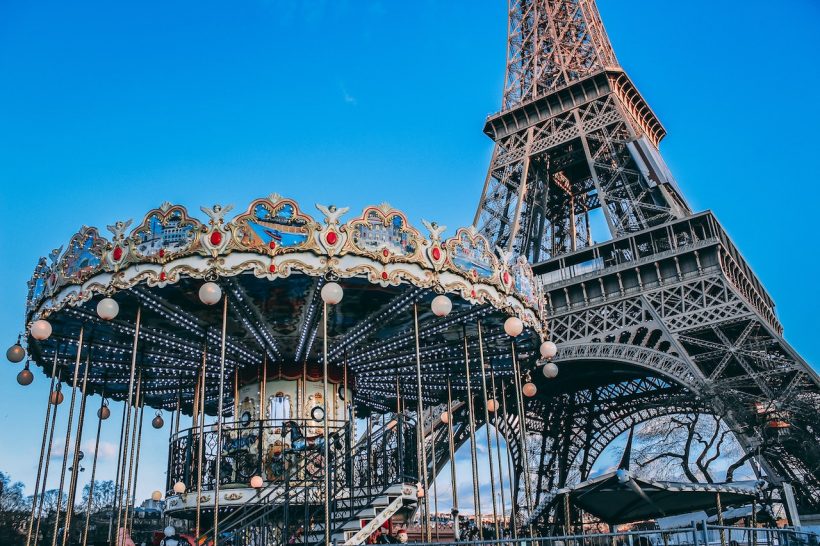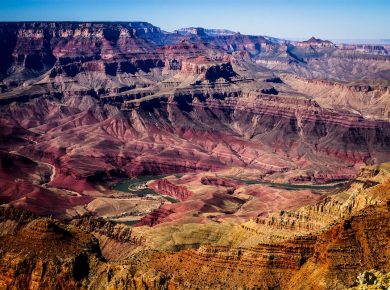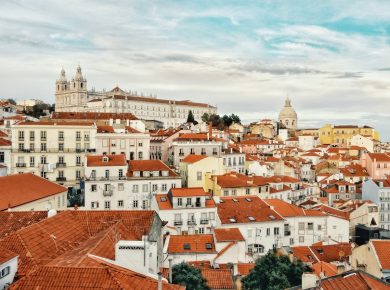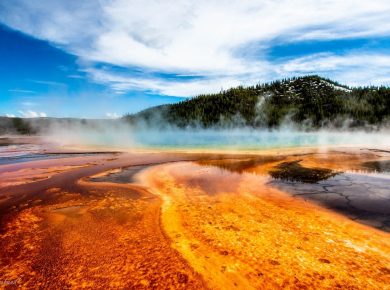Are you looking for the perfect window to make your trip to the City of Lights? We’ve got you covered. Your Paris experience may vary by season, but it has special magic year-round. Many have their opinions about the best time to visit.
The best month to visit Paris is August. It’s time when peak tourism ends and business trip season has yet to ramp up. The crowds are shockingly small, and the weather is sightseer-friendly.
Each month has its pros and cons affecting travel. Want to enjoy the summer weather and bask in the sun in front of the Eiffel Tower? Maybe you’d like to take a picnic in the Luxembourg Garden? Unfortunately, you chose peak season, and you’ll have to deal with the masses from around the world who had the same idea. You’ll face stiff competition for that picnic spot.
You may have heard that fewer tourists visit in the winter. You go and don’t have to stand in line to get into the Louvre, but you nearly freeze every time you go outside! The dreary winter atmosphere may not live up to what you heard about the picturesque City of Love.
Many travel guides list all the fantastic things you can do in certain months or seasons in Paris. It seems like every month is perfect. However, it’s essential to plan your trip carefully if you’re sensitive to weather conditions and crowds. Taking into account tourist traffic patterns and average weather, we will determine the best month to visit Paris.
Table of Contents
Average Temperature In Paris
Luckily for all, Paris has relatively mild temperatures year-round. You’re highly unlikely to encounter extreme temperatures that ruin your trip.
The hot months last from mid-June to mid-September, with July being the hottest. However, these warm months aren’t nearly as bad as summer heat in places like the United States. The average high temperature of the season is 71°F, peaking at a balmy 75°F in July. The low for these months drops to 58°F, so bring a light jacket.
The cold months hugely outlast the hot in Paris. You can catch the city at its coolest between mid-November and early March, with daily temperatures maxing at 51°F. Bring warm clothes for these months, especially in January when temperatures range from 36°F to 44°F.
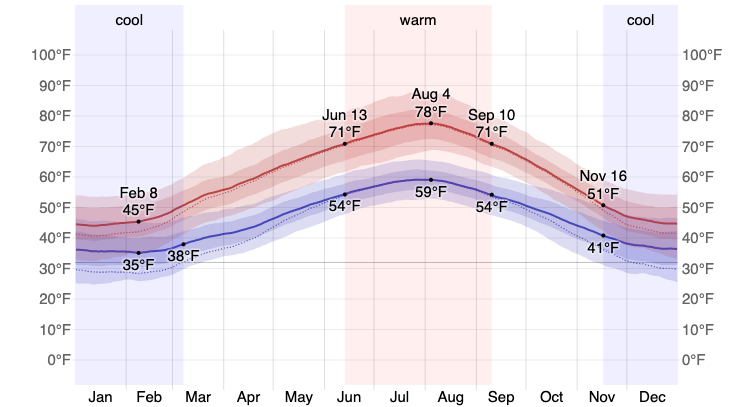
Daily Chance Of Precipitation In Paris
Staying dry is key to the success of any vacation in the city. Avoiding rainy days can be tricky but not impossible. Luckily Paris rain doesn’t ceaselessly drizzle down as in London or Seattle. However, book accordingly if you want to steer clear of getting wet.
Thanks to a low amount of precipitation, Paris doesn’t have clear-cut dry and wet seasons, just “drier” and “wetter” ones. The longest period of dry weather in Paris spans February and March. The chance of precipitation hovers around 20% for a given day. However, that doesn’t mean that the rest of the year faces downpours. In fact, August has the lowest average number of rainy days in Paris, about 6.6 on average.
Even in the “wet” season, there’s only a maximum 30% chance of rain on a given day in May, the wettest month. It hits 30% again in January when snowfall is normal. Your best chances of staying dry are in August, February, and March. Packing an umbrella would be wise should you choose to visit in spring. Book your trip to Paris in January if you’d like to see the streets covered in a blanket of snow.
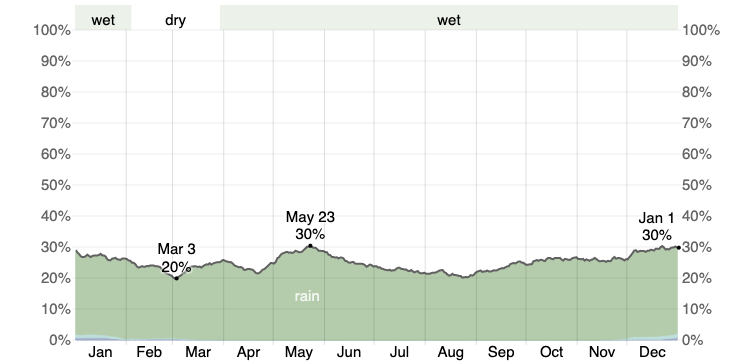
Humidity Comfort Levels In Paris
It can be tough to enjoy yourself on a hot, muggy day. It might be nice while sitting drink-in-hand at a seaside resort but not while waiting in line to get into the Notre Dame cathedral. When should you book to avoid the Paris humidity?
Like other European countries, Paris only experiences humid weather mainly in the summer months, the most intense being July. There’s at least a 2% chance of humidity any day of the summer, and it jumps up to a 4% chance in late July. Remember to look for a room with air conditioning if booking your trip in the summer. You’re unlikely to be hit by muggy weather in the spring, fall, or winter, as the chances drop down to 0%.
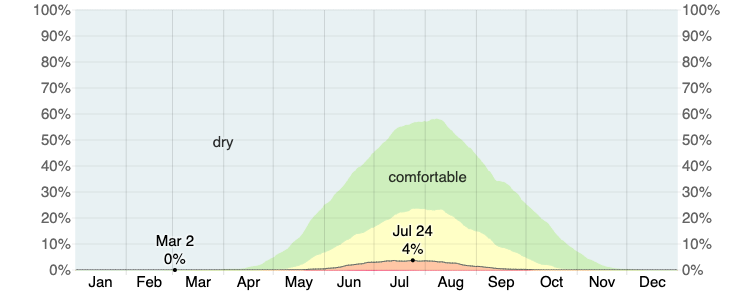
Best Time Of Year To Visit Paris For Great Weather
The weather is quite forgiving to tourists, but when is the best weather in Paris? When is the weather more likely to enhance your experience than rain on your parade?
There are two factors to decide this: the “tourist score” and the “beach/pool score.” The first is used to determine how pleasurable outdoor activities like sightseeing tours are in a given month. Clear skies and temperatures between 65°F and 80°F are the criteria here. According to Paris’s tourist score, the best time to visit for these conditions lies between June and September. The end of July is the peak in this golden window.
The “beach/pool score” tells whether a particular month is conducive to time spent by the pool or beach. Like the “tourist score,” it also rewards clear days but seeks higher temperatures ranging from 75°F to 90°F. Mid-July to mid-August is the best time to go for a swim in the city. Based on both scores, the summer months are the best time to be outdoors in Paris. It’s warm but not too hot, and there’s minimal precipitation.
Best Time Of Year To Visit Paris For Low Prices
It’s no secret that Paris can be a pricey destination. The time of year you book has a massive influence on what you pay for flights and accommodation. Nevertheless, there are ways to save when planning your trip!
Tourism in late spring and early autumn is rising. The weather is the fairest, so everyone wants to come. Flight prices spike due to interest. Accommodation rentals are a challenge too. If you were worried about finding a reasonable price, you’d also discover that competition from fellow tourists makes finding any room difficult.
The peak season is split in half by August when Parisians abandon the city for their own trips. Heat is another factor, as most fear melting on the city streets on their dream holiday. These make August a relatively quiet time to visit. Tourist traffic is low, and your only chance of landing a hotel deal in the summer is here.
The winter months of November to February see the lowest numbers of tourists, cheapest flights, and best accommodation deals. You’ll spend the least of any season should you choose to come in the winter. Visiting Paris in the winter doesn’t mean you’ll miss out on all the magic that the summer tourists get.
Unlike the summer vacationers, you won’t have to deal with long lines at major attractions. You’ll be bragging about the city’s Christmas markets, light displays, and outdoor ice skating to your friends who went in July. Disneyland Paris, one of the biggest draws for foreign tourists, is at its quietest and cheapest in the winter too. Layer up for the winter, and save up by buying cheaper tickets.
When Should You Go To Paris?
Peak Travel Season In Paris
Not everyone has a schedule allowing them to travel any time of the year. If you have kids or a strict work schedule, you might be unable to avoid traveling during peak season. Don’t stress, though. Paris is a bit different from other European cities and summer visits may not be such a bad idea. Here, we will determine the city’s three tourist seasons and what to expect from them.
The peak season coincides with the summer holidays. Expect crowds and heat. During this time, Paris is crawling with families and college students, making the most of their breaks. High temperatures can prove problematic too. Many establishments in the city lack air conditioning, and the summers get hotter every year.
Don’t think that this makes Paris off-limits in the summer, though. Their peak season differs drastically from other European capitals. As previously mentioned, tourist traffic decreases in July and August. The French go on vacation in August, and most opt for cooling off down south by the sea. Hotel rooms are available in considerable quantities in late summer due to the lack of business trips in the city. If you can stand the heat, you’ll beat the crowds.
Many businesses shut down for vacation at this time, but the tourist economy is not affected. Cafés, restaurants, and tourist attractions still run full steam, so you won’t miss out if visiting during French vacation time.
Low Travel Season In Paris
The chilly off-season may be more suitable if you have a flexible schedule. Firstly, you’ll probably save money on airfare as the prices drop dramatically in the winter. Paris hotel prices also see a huge decrease around this time. Higher-end hotels that you wouldn’t even consider booking during peak season might become affordable. Budget options are plentiful as well.
Compared to the summer crowds, you’ll sometimes feel as though you have the city to yourself! You’re bound to run into fellow tourists- this is Paris, after all. However, the famous sights won’t be nearly as congested. You and the few brave enough to face the cold will be rewarded with quiet visits to the Eiffel Tower and strolls down Champs-Élysées. Even Seine river cruises run in the winter, complete with heated enclosures and blankets for comfort.
Just remember that it’s not only cold but sometimes wet. December and January can bring lovely snow blankets but possibly icky, cold rain. Gray skies and early sunsets may be another turnoff to travelers, but some may appreciate such a moody atmosphere.
Finally, slower tourist traffic may lead to shorter working hours at tourist attractions. Plan ahead and find out when places close for the day to make sure your museum visit isn’t cut short. Luckily, no attractions close down altogether during low season as in other cities, so there’s no threat of missing out on the most iconic Paris experiences.
Shoulder Travel Season In Paris
The “shoulder season” falls in between the other two. You’ll find neither huge crowds nor abandoned avenues. Paris has two shoulder seasons, coinciding with spring and fall, respectively. It may be tough to get away from work, but if possible, it’d make for an unforgettable time spent hitting the Paris streets.
Both seasons boast nice weather and smaller crowds. You’ll get more sunshine than in the dark winter months too. Just remember that May is an outlier for the weather. Your chances of getting rained on are greater but don’t expect downpours.
September and October see bigger crowds than the rest of the shoulder season due to an uptick in conventions and trade shows. Deals will be tough to find, but availability is no problem. Just look in the usual tourist parts of the city, and avoid staying in business districts.
Best Month To Visit Paris
Though any month spent in Paris is sure to be a magical time you will cherish forever, some tick more perfect condition boxes than others.
The allure of beating crowds and saving on flights in the off-season is a huge advantage. However, you might freeze or get rained on! Is it worth saving money on flights if the weather gets in the way? The shoulder season also sounds promising, but choose the wrong week, and you risk the chance of rain or hotels packed with business people!
August probably comes to mind last. One immediately thinks of blazing heat and tourist mobs and writes it off. However, the city’s tourism trends differ from those of other European capitals. While the Parisians are away, the tourists can come out to play. Though the month is associated with hot temperatures, July bears the brunt of the summer heat’s peak. August also has the lowest number of rainy days in Paris. Finally, due to the lull in tourism, you don’t have to pay peak season prices on hotels.
A true wildcard in tourism, August is the best month to visit Paris. It’s the eye of the storm where tourism ends and business trip season has yet to ramp up. The crowds are shockingly small, and the weather is sightseer-friendly. Just pack some sunscreen!
